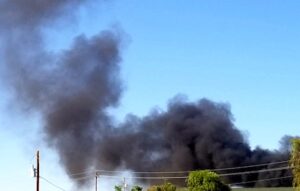Navigating the Home Restoration Process After a Fire Outbreak
Dealing with the aftermath of a fire outbreak can be a daunting experience. It’s not just about the physical damage to your home; it’s also about rebuilding your life. In this comprehensive guide, we will walk you through the intricate process of navigating the home restoration journey after a fire incident. From assessing the damage to handling insurance claims and finding professional help, we’ve got you covered with this step-by-step guide. Now let’s get into this detailed guide on how to navigate the home restoration process after a house fire.

1. Assess the Extent of the Damage
The first step in any post-fire restoration process is to assess the full extent of the damage. Fire damage usually goes beyond the visible. Structural issues, smoke residue, and water damage from firefighting efforts are often hidden challenges. To get a complete picture, consider hiring a professional fire damage assessment team.
According to the National Fire Protection Association (NFPA), in 2019, over 1.3 million fires were reported in the United States alone, resulting in billions of dollars in property damage. Assessing the damage accurately is essential to accessing insurance claims.
2. Contact Your Insurance Provider
Your homeowner’s insurance is your lifeline during this crisis. Most of the fire damage will likely be covered by your homeowner’s insurance, so this might relieve you during this trying time. After assessing the damage, promptly contact your insurance provider to initiate the claims process.
When the insurance adjuster arrives, you will provide detailed documentation, including photographs and an inventory of damaged items. So it’s advisable to take photos as you assess the damage. It’s painful and sad, but it’s the best you can do at this point for your best interest.
Also, while most insurance policies cover fire damage, the specific coverage can vary. According to the Insurance Information Institute (III), the average claim payout for fire damage in the United States in 2020 was around $79,785. This highlights the importance of having a robust insurance policy.
3. Contact a Restoration Team
Once the insurance has been sorted, call a reputable fire damage restoration company near you. These experts have the knowledge, skills, and equipment needed to handle the intricate process of restoring your home to its pre-fire condition. They’d also address the smoke, water, and mold issues.
Note that you don’t have to receive the insurance money before you can begin the restoration process. As soon as the insurance adjuster comes and your claim has been established and agreed upon, repairs can start. When the insurance money arrives, you can use that to offset the cost.
Choosing a professional restoration company can significantly improve the outcome of your fire-damaged property. So you want to choose right.
4. Secure Your Property
After a fire, your home may be vulnerable to further damage from the elements or even looting. Take steps to secure your property during the early stages of recovery. This, of course, should be after you have assessed and documented the extent of the damage. This proactive approach will help prevent additional problems while you work on the restoration process.
Boarding up windows, tarping the roof, and locking all entrances are essential steps. These measures protect your home from rain, wind, and potential intruders. This will help minimize the risk of further damage.
5. Create a Comprehensive Restoration Plan
With the damage assessment in hand and a skilled restoration team at your side, it’s time to create a detailed restoration plan. This plan should outline the steps, timeline, and budget for the restoration process, providing a roadmap to guide you through each stage of recovery.
On average, the restoration process for a moderately damaged home can take several months. So, it’s best to look for somewhere to keep your family safe for the time being. Extended family can help. Having a well-thought-out plan can help keep the restoration project on track to finish faster.
6. Structural Repairs
Depending on the severity of the fire, structural repairs may be necessary. Ask your hired restoration service if they also handle structural damage or if you need to call another expert for that. These repairs include assessing and addressing damaged walls, floors, and ceilings. Ensuring the structural integrity of your home is not only crucial for safety but also for the overall stability of the property.
7. Electrical and Plumbing Issues
Fire damage can compromise your home’s electrical and plumbing systems, posing potential safety hazards. So you might want to call the electrical and plumbing companies at this point. You could do that, just to get the cost. Most times, it’s advisable to wait until after the fire and structural damage have been restored before fixing plumbing and electrical issues.
8. Restoring Personal Belongings
Salvaging personal belongings is often an emotional aspect of the process. While some items may be beyond repair, professionals can often restore valuable possessions, including sentimental items like photos, paintings, and heirlooms. This restoration process can provide a sense of closure and comfort during a challenging time.
Moving into Your Home Post-Restoration
Your home has been restored, and all the smoke, mold, structural, and water damage has been addressed. But before moving back into your home, get final inspections and approvals from relevant authorities. This ensures your home is safe and complies with all building codes and regulations. It will provide you and your family peace of mind, so don’t ignore this.

Frequently Asked Questions (FAQs)
Q: How long does the home restoration process typically take?
The duration varies depending on the extent of the damage. It can take several weeks to several months.
Q: Will insurance cover all the restoration costs?
It depends on your policy. Some costs may be covered, but you may have to cover certain expenses.
Q: Can I stay in my home during the restoration process?
It’s usually not safe to stay in a home undergoing restoration. You may need temporary accommodation.
Q: How do I ensure my belongings are protected during restoration?
Work with your restoration professionals to safely store or clean your belongings during the process.
Q: Is it possible to salvage sentimental items damaged by the fire?
In many cases, yes. Restoration experts can often restore sentimental items like photos and heirlooms.
Q: What should I do to prevent future fire outbreaks?
Install smoke detectors, have fire extinguishers on hand, and create a fire evacuation plan for your family.
Q: How to Deal with Emotional Turmoil After a Fire in Your Home?
Here are some ways to cope with the emotional stress:
- Accept Your Feelings
- Seek Emotional Support
- Practice Self-Care
- Stay Informed
- Focus on the Future
- Document Your Experience (If you didn’t know, writing can help you deal with trauma and stress)
- Connect with Others Who’ve Experienced Similar Events Joining a support group or online community of people who have gone through similar experiences can provide a sense of camaraderie and shared understanding.
In Closing
The home restoration process after a house fire outbreak is no doubt a daunting journey. But having the guide above, you are armed with the right knowledge to tread this difficult path and emerge successful. Remember, you’re not alone. And it’s not just about restoring your home and property; it’s about rebuilding your life. So, while the structural works are going on, don’t forget to be with those who love you—don’t forget to live.
